
Sauroposeidon is a genus of sauropod dinosaur known from several incomplete specimens including a bone bed and fossilized trackways that have been found in the U.S. states of Oklahoma, Wyoming, and Texas.
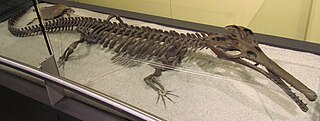
Champsosaurus is an extinct genus of crocodile-like choristodere reptile, known from the Late Cretaceous and early Paleogene periods of North America and Europe (Campanian–Paleocene). The name Champsosaurus is thought to come from champsai, (χαμψαι) said in an Ancient Greek source to be an Egyptian word for "crocodiles", and sauros, (σαύρος) Greek for "lizard". The morphology of Champsosaurus resembles that of gharials, with a long, elongated snout. It was native to freshwater environments where it likely preyed on fish, similar to living gharials.

Mekosuchus is a genus of extinct Australasian mekosuchine crocodilian. Species of Mekosuchus were generally small-sized, terrestrial animals with short, blunt-snouted heads and strong limbs. Four species are currently recognized, M. inexpectatus, M. whitehunterensis, M. sanderi and M. kalpokasi, all known primarily from fragmentary remains.
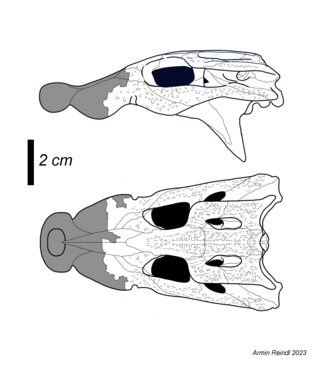
Trilophosuchus is an extinct genus of mekosuchine crocodilian from Australia. Its fossils have been found at the Ringtail Site in the Riversleigh World Heritage Area and date to the Miocene epoch. Additional remains have also been found at the older Hiatus Site and extend its range into the Oligocene. Like the closely related Mekosuchus, it is thought to have had a short and blunt snout and large eyes that generally resembles today's dwarf crocodiles. It also shares similarities with several much older crocodylomorph groups and is commonly thought to have been more terrestrial than any crocodilian living today. Only a single species has been described, the type species T. rackhami.
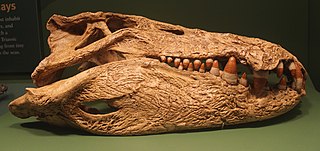
Mahajangasuchus is an extinct genus of crocodyliform which had blunt, conical teeth. The type species, M. insignis, lived during the Late Cretaceous; its fossils have been found in the Maevarano Formation in northern Madagascar. It was a fairly large predator, measuring up to 4 metres (13 ft) long.

Anatosuchus is an extinct genus of notosuchian crocodylomorph discovered in Gadoufaoua, Niger, and described by a team of palaeontologists led by the American Paul Sereno in 2003, in the Journal of Vertebrate Paleontology. Its duck-like snout coincidentally makes it resemble a crocoduck, an imagined hybrid animal with the head of a crocodile and the body of a duck.

Dromicosuchus is an extinct genus of sphenosuchian, a type of basal crocodylomorph, the clade that comprises the crocodilians and their closest kin. It was found in Upper Triassic rocks of North Carolina, United States, and is known from a nearly complete skull and partial skeleton. This specimen is unusual in that it was found beneath the skeleton of a larger rauisuchian and has apparent bite damage, suggesting that it was attacked by the larger carnivore before both died and were buried together.
Rugosuchus is an extinct genus of neosuchian crocodyliform from the late Early Cretaceous of China. It is known from most of a skull, a partial postcranial skeleton, and a second partial skeleton including part of the hips. It was described by Xiao-Chun Wu and colleagues in 2001, with R. nonganensis as the type species. At the time of its description, it was the most complete crocodyliform from northeastern China, and only the second known.
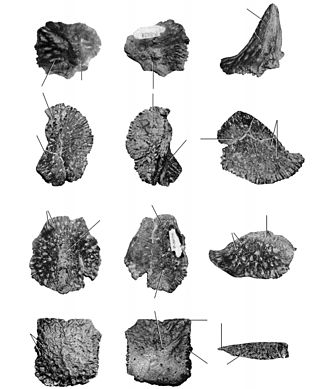
Akanthosuchus is an extinct genus of alligatoroid crocodilian, possibly an alligatorine. Its fossils are found in the Paleocene-age Nacimiento Formation of the San Juan Basin, New Mexico, USA. It is known from a partial skeleton and isolated bony armor. Its armor was distinctive, with spike-shaped and blade-shaped pieces, and it is the only known crocodilian with a combination of both.

Eusuchia is a clade of neosuchian crocodylomorphs that first appeared in the Early Cretaceous, which includes modern crocodilians. Along with Dyrosauridae and Sebecosuchia, they were the only crocodyliformes who survived the K-T extinction.
Pinacosuchus is an extinct genus of crocodylomorph. Its fossils were found in the Late Cretaceous-age North Horn Formation of Utah. Pinacosuchus was a diminutive crocodylomorph with spiky armor, and is known only from meagre remains.
Gilchristosuchus is an extinct genus of neosuchian crocodyliform. Its fossils have been found in the upper Milk River Formation of Alberta, Canada, in rocks of either latest Santonian or earliest Campanian age. Gilchristosuchus was described in 1993 by Wu and Brinkman. The type species is G. palatinus, in reference to its distinctive palatine bones.

Fruitachampsa is a genus of shartegosuchid crocodyliform from the Upper Jurassic Morrison Formation of Colorado. It is known from multiple specimens that show it to have been a relatively long-limbed terrestrial quadrupedal predator less than 1 metre (3.3 ft) long, with a short face and a prominent pair of canine-like teeth in the lower jaw. Before it was formally described in 2011, it was also known as the "Fruita form". Its type species is F. callisoni.
Heterosuchus is an extinct genus of crocodylomorph that may have been a eusuchian. It is known only from neck and back vertebrae recovered from Early Cretaceous-age rocks of the Hastings Beds of Hastings, Sussex. These vertebrae are procoelous, which is a trait of eusuchians. Heterosuchus was described by Harry Seeley in 1887, with H. valdensis as the type species. It may be the same genus as the slightly younger Hylaeochampsa, inferred to have been of similar evolutionary grade, but there is no overlapping material as Hylaeochampsa is known only from a partial skull; Hylaeochampsa would be the name used for both in that case, because it is the older name. Because of the sparse material and apparent lack of distinguishing characteristics, James Clark and Mark Norell (1992) considered Heterosuchus a dubious name.
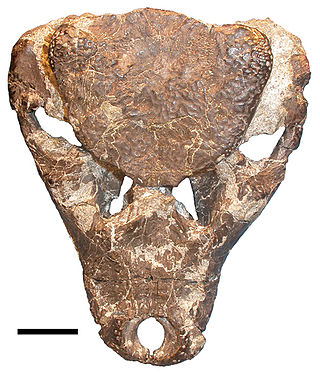
Hylaeochampsidae is an extinct family of basal eusuchian crocodylomorphs thought to be closely related to the order Crocodylia.
Kayentasuchus is a genus of sphenosuchian, a type of basal crocodylomorph, the clade that comprises the crocodilians and their closest kin. It is known from a single skeleton found in rocks of the Sinemurian-Pliensbachian-age Lower Jurassic Kayenta Formation, northeastern Arizona.

Susisuchus is an extinct genus of neosuchian mesoeucrocodylian crocodyliform from the Early Cretaceous of Brazil. Fossils have been found from the Nova Olinda Member of the Aptian-age Crato Formation in the Araripe and Lima Campos Basins of northeastern Brazil. Named in 2003, Susisuchus is the sole member of the family Susisuchidae, and is closely related to the clade Eusuchia, which includes living crocodilians. The type species is S. anatoceps, known from a single partial articulated skeleton that preserves some soft tissue. A second species, S. jaguaribensis, was named in 2009 from fragmentary remains.
Paluxysuchus is an extinct genus of neosuchian crocodyliform known from the Early Cretaceous Twin Mountains Formation of north-central Texas. It contains a single species, Paluxysuchus newmani. Paluxysuchus is one of three crocodyliforms known from the Early Cretaceous of Texas, the others being Pachycheilosuchus and an unnamed species referred to as the "Glen Rose Form". Paluxysuchus has a long, flat skull that is probably transitional between the long and narrow skulls of many early neosuchians and the short and flat skulls of later neosuchians.
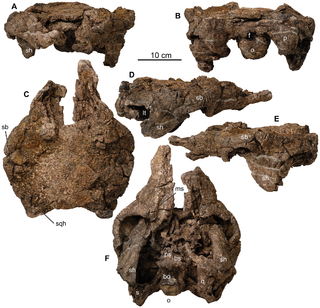
Europelta is a monospecific genus of nodosaurid dinosaur from Spain that lived during the Early Cretaceous in what is now the lower Escucha Formation of the Teruel Province. The type and only species, Europelta carbonensis, is known from two associated partial skeletons, and represents the most complete ankylosaur known from Europe. Europelta was named in 2013 by James I. Kirkland and colleagues. Europelta has an estimated length of 5 metres and weight of 1.3 tonnes, making it the largest member of the clade Struthiosaurini.

Confractosuchus is a genus of extinct eusuchian crocodyliform from the Cretaceous Winton Formation of Australia. Described as a macro-generalist, Confractosuchus was found with the bones of a juvenile ornithopod dinosaur in its abdomen. It currently contains a single species, Confractosuchus sauroktonos, which literally means "broken dinosaur killer."

















